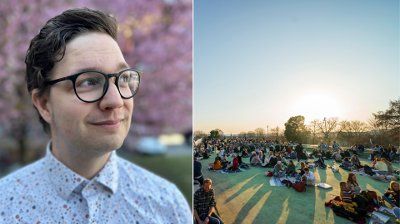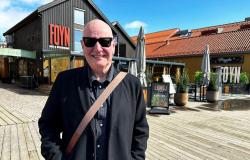Columnist This text expresses the writer’s personal attitudes.
The discussion about what is good architecture is often about the last building to be completed: Voldsløkka school, the Darth Vader house, Munch, the new project above the Vinmonopolet in Theresesgate. Is it ugly or pretty, good or bad architecture, a subsidy or a cost for the area?
Four things to learn from Akersbakken 39
But what about all the houses that have already been there for a while? At one point, a building has been the newest in the street and everyone has discussed and opined a lot about that particular building.
As time goes on, it will join the series of facades and houses that are part of our daily architectural scenography. We don’t think especially over it on the way to school, work and kindergarten.
To find examples of good and beautiful architecture, it can be fun and instructive to take a look at those that have stood there for a while.
Our city is full of architectural jewels and the one I want to take a closer look at is Akersbakken 39.
You rarely need a tower on your house, but Akersbakken 39 has one and it immediately gives a feeling of surplus
1. A feeling of excess
The building I’m talking about is located on the corner where the uphill road in Ullevålsveien along Vår felsers gravlund meets Akersbakken, on the right. It was built in 1987, originally consisted of 62 apartments and was designed by architect Jon Kåre Schultz.
The first thing you notice until when you look up at the building there is the octagonal tower at the corner of the building. The tower as a building element is not a new invention, but in the fauna of residential buildings in Oslo, the tower can be considered a surplus project. You rarely need a tower on your house, but Akersbakken 39 has one and it immediately gives a feeling of surplus.
Columnist: Magnus Ravlo Stokke
Magnus Ravlo Stokke (43) writes about architecture, city life and everyday life in Avisa Oslo. Stokke studies architecture at AHO and lives in an apartment in an apartment building from 1892 in Bislett/Fagerborg. He is married and has four boys aged 3-14.
- Preferred means of transport: E-bike with long child seat in everyday life, and a Volvo XC90 when I go to Thaugland to buy materials.
- Can most often be found at the bar Rouleur, in the middle of the intersection on St Hanshaugen. We got married here. Oslo’s best place for a beer, summer and winter.
- Oslo’s finest building is Kunstnernes Hus. Obvious qualities both outside, inside and in its surroundings, and so rich in more subtle details and architectural craftsmanship. (The only minus is that it is poorly adapted for wheelchair users.)
- Oslo is at its best when you are cycling without your hands on the handlebars on your way to something pleasant at the beginning of May.
2. Works both in daylight and in the dark
Arriving from Stensberggata, you are greeted by the tower as a background motif at the end of the street. The tower on one side, the dove trees of the cemetery on the other side of the street. It is a visual section that balances the green and natural on the one hand, and the peachy and man-made on the other, and everything is bathed in sunlight.
In addition to the tower, you also immediately see the stairwell to the left of the tower in the facade; glass building blocks in equal fields upwards, asymmetrical in relation to floor dividers, but with its own logical division.
In the evening, the stairwell lights up, the stairs are clearly marked on the outside, without us fully seeing who is moving inside. The glass building block makes the stairwell feel more like a diffused lantern than a blindingly illuminated, vertical building element.
The building has attraction. You are led towards something and the reptilian part of our brain makes us, like all other creatures, move towards the light. The house simply works well both during the day and when it is dark.
Participate in the Oslo Debate
Do you have an opinion on this matter, or another topic? Submit your debate entry here
Oslo people have many opinions about their city, and Avisa Oslo wants to publish more personal and original posts that enrich the public debate.
3. Good architecture has a bit of humor in it
If you come down the street from St. Hanshaugen, the windows are eye-catching. There are squares and circles of various sizes and a large triangle – the tower top – at the top.
Postmodernism’s playful idiom, with its somewhat excessive use of such geometric figures and reinterpretations of classical building elements, is probably considered by many to be somewhat vulgar. But when it was built in 1987, it was a backlash against modernism’s strict forms, symmetry and repetition.
The stingy forms is actually a bit of obscene play and fun with the builders’ capital! It’s just a bit of fun. These are not square adult windows – here someone has had to be alone at home and design windows. It has given the building a sense of humour.
Take a look the next time you pass the building on your way to work and need a beacon to show you the way in the dark
4. The building and the surroundings can coexist
From Akersbakken, the first thing you notice is the curved window openings, which also look like oversized, circular pilasters (built-in “pillars” in the facade without a constructive function). They step gradually closer to the street, the closer you get to Ullevålsveien. Curved windows are extremely much more expensive than flat windows, so the design of the windows on the bay windows goes directly into lesson 1: Good architecture gives a sense of excess.
The withdrawn facade means that any property developer can think that the area between the building and the street lane was lost income in the form of unused building area. The choice to allow the building to bend and retreat allows the detached neighboring town villa from the 19th century opposite in Akersbakken to stand and shine for itself. It is an incredibly sympathetic feature of the urban adaptation the building represents.
Not all good architects are named Sverre Fehn
Architect Jon Kåre Schultz is one of countless architects we have not learned about at the School of Architecture. It is a building that looks out over the cemetery and welcomes St. Hanshaugen. It has been carried out with precision, with professionalism in every detail and with great focus on not only the building’s users, but also all of us who live nearby.
Take a look the next time you pass it on your way to work and need a beacon to guide you in the dark.
Read more comments, debate posts and Oslo stories on Avisa Oslo’s debate page Oslodebatten
also read
“Upgrade the tram tracks, but just not in my street”
also read
At Oslo’s best crossroads, everything is a little here and a little there

also read
I survived a week outside Ring 3

also read
Dear St. Hanshaugen. I hope our relationship does not end in tragedy
Tags: Culture nightlife Architecture home design windows bit fun
-








